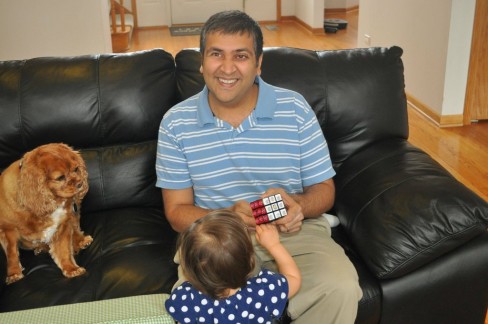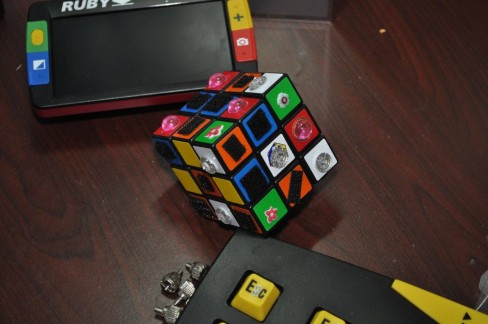Do you take your sense of touch for granted?
“Also note that invariably when we design something that can be used by those with disabilities, we often make it better for everyone.”
-Donald Norman
Sameer Doshi, recently blind, has taken to modifying his environment to make it easier for him to use. While this is common practice for those with significant to severe vision loss, it’s not something that those of us without a vision impaired friend or loved one have probably thought a lot about. One of the ways that he has done this is by adding stickers, bumps, and pieces of velcro to identify buttons by feel. He explained to me that he has modified household items and appliances such as his dishwasher, microwave, and keyboard. For example, he placed little plastic bumps on the buttons of his microwave in such a way as to differentiate the “start”, “add 30”, and “popcorn” buttons from one another.

Missing the games that he used to enjoy, he recently modified a Rubik’s cube so that it could be played completely by feel. To me, this seems like it would make an already very difficult puzzle more challenging. As you can see that didn’t stop Sameer from solving it. He used velcro squares, plastic gems of differing shapes, and [I’m guessing] his daughter’s Dora the Explorer puffy stickers to tell the various sides / colors of the cube apart. He noted that the hooks and loops of velcro feel distinct, so he was able to use each of these textures for a different side of the cube.
This got me thinking about some recent electronic devices that I have been designing. I explained to Sameer that I have been working very hard to ensure that each of the buttons that I use can be differentiated by feel. I have noticed that I am often trying to work electronic devices in the dark and that it can be quite challenging depending on the attention paid to the tactile differentiation of the keys, etc. Sameer mentioned that the Nintendo SNES controller was a great example of tactile design, as its designers used both concave and convex buttons to great effect. He also suggested that I consider using differing textures on my buttons in addition to the other cues that I had considered such as differing materials, convexity vs. concavity, bumps of various sizes, etc.
I am embarrassed to admit that even though I am a rabid fan of noted interaction designer, Don Norman’s books [which discuss the tactile aspects of design], it hadn’t occurred to me that I was actually making these devices easier to use for the visually impaired. In seeing Sameer’s “Tactile Cube” I was reminded that the ways in which users modify objects to suit their needs can be a great source of insight into how to make products better.
What products that you have used are easy to use by feel alone? Can you think of any gadgets that are frustrating to use in the dark? Please post your responses in the comments below!
Sameer is currently running for Representative in the 82nd district of Illinois. You can find out details and volunteer here. Additional information about modifying the environment for the visually impaired can be found at VisionAware.org. I originally became aware of Sameer when he posted the pictures show here on Reddit.com.
